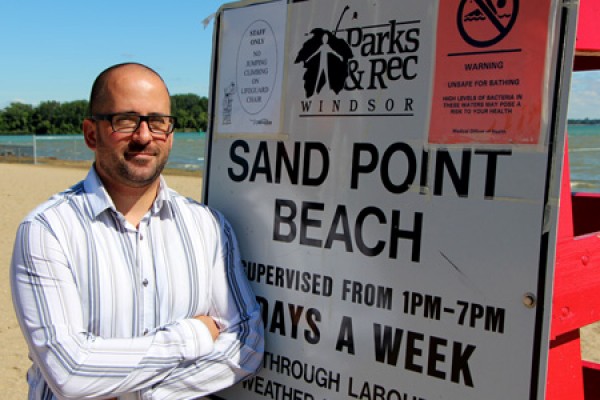 Kerry McPhedran stands beside a warning sign posted on a lifeguard stand at Sandpoint Beach. The post-doctoral fellow believes predictive modelling may be a better way to determine whether beaches should be closed to swimmers.
Kerry McPhedran stands beside a warning sign posted on a lifeguard stand at Sandpoint Beach. The post-doctoral fellow believes predictive modelling may be a better way to determine whether beaches should be closed to swimmers.
An engineering researcher believes there may be a better way to warn local bathers about when it’s safe to go swimming at area beaches.
Kerry McPhedran, a post-doctoral fellow in civil and environmental engineering, believes a system that relies on modelling to predict whether bacteria levels are too high to swim might be a better alternative to current methods, which are unable to provide up-to-date conditions.
Dr. McPhedran, who recently authored a paper on the subject with his academic supervisor and professor Rajesh Seth that was published in the Water Quality Research Journal of Canada, said most municipalities collect water samples from beaches, conduct a 24-hour standard culture test, and then post warnings about whether it’s safe to swim after they obtain the results.
“It really doesn’t make a difference whether they do it weekly or daily because it takes so long to do the test,” he said. “It gives you the past quality, not the current conditions. Conditions change daily, even within the day itself. Those numbers could change quite dramatically within 24 hours. But the bigger issue is if they get a false negative and keep the beach open when it may not be safe.”
In a pilot project funded by the Essex Region Conservation Authority, McPhedran analyzed water samples collected from Sandpoint Beach and Holiday Beach over 30 days in the summer of 2010. While he did find a number of days in which the levels for both E. coli and Enterococcus, the two fecal indicator bacteria most commonly used to measure for water safety, exceeded acceptable levels, he said the bigger issue is the fluctuations of those levels on a day-to-day basis.
“Sampling over a 30-day period allowed us to better understand the way things change and just how dynamic these systems really are,” said Dr. Seth.
According to his paper, McPhedran found positive correlations between high bacteria levels, and water turbidity, wind direction, wave heights, rain fall and water temperatures. Given the absence of fast, reliable tests, he believes a predictive model based on data about all of those other conditions could be created to better predict whether bacteria levels are low enough for swimming.
He did, however, caution that more extensive research would need to be conducted in order to collect enough data to make such a model truly reliable.
“We’d need more comprehensive data to be collected over a greater period of time,” he said. “The strength of your model has to be based on your data set.”
